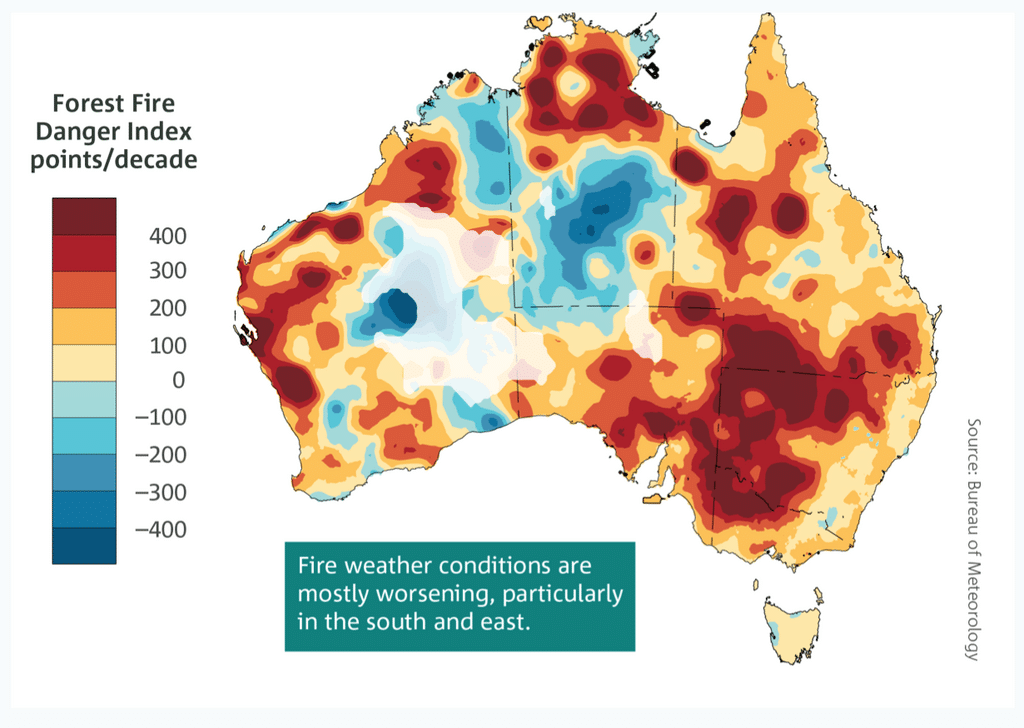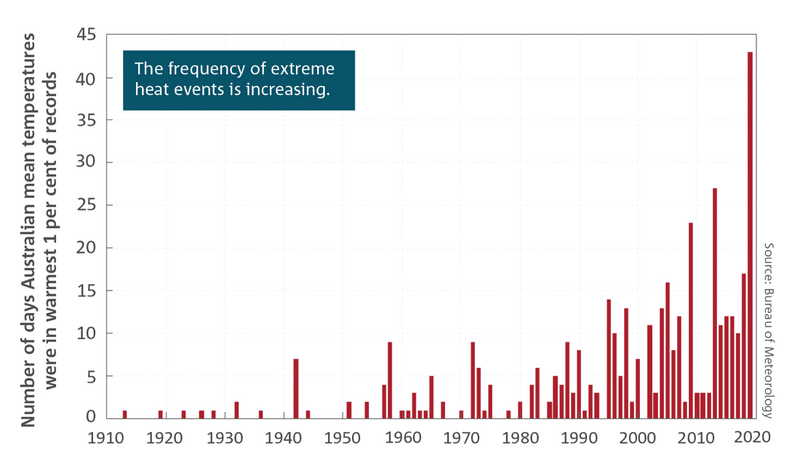Bushfires, high intensity fires burning in a wild area of land that spread rapidly, are usually extremely difficult to control and can thus, smoulder for days on end. They are very common in dry and hot climates such as Australia, where they have become a regular occurrence. We explore the main causes and consequences of the Australia wildfires and bushfires, and whether the Australian government has any solution in sight.
—
News that residents of Yeagarup, about 300km south of Perth, were urged to leave the area due to a life-threatening bushfire in the early hours of March 12, 2022, brought back memories of the deadly Australian Black Summer that took place just two years ago. During this historic wildfire season of 2019 and 2020, extreme bushfires tore through New South Wales and Queensland in southeastern Australia, burnt 42 million acres, destroyed thousands of buildings, as well as killing dozens of people and 3 billion animals.
What is currently happening in Western Australia is just the latest example of an ongoing emergency that has been affecting the bushfire-prone country, from east to west, for decades. Some other examples of the most destructive wildfires in the country’s history are the 1939 Australia fires, gone down in history as Black Friday, during which nearly 4,000 homes across the state of Victoria were destroyed; the 1974-75 Australian bushfire season, which impacted 15% of the country’s physical land mass; and the more recent 2009 Black Saturday bushfires, which claimed the largest number of human lives.

Figure 1: Forest Fire Danger in Australia
You might also like: A Crisis of the Australia Bushfires: A Government’s Failure
1. Cause of Australia Fires
For a bushfire to start, there needs to be an ignition source. This can be a natural event, such as lightning strikes or spontaneous ignition, or it can be directly linked to human activities, such as vehicle fires, cigarette butts or campfires. From there, the risk of a fire developing is driven by four main factors: dry fuel such as leaves, grass, and branches, high temperatures, strong winds and dry air.
While the eastern part of the country is one of the world’s most fire-prone regions, with New South Wales and the Northern Territory of Australia being the main scene of extreme wildfire events, its Western regions are not spared either. Indeed, previous bushfires go to show that with the right conditions, blazes can occur in many other areas. The vast majority of the country is characterised by hot and dry climate. This, matched with strong winds, makes for ideal conditions for wildfires. Changing wind patterns, a steady decline in rainfall and rising temperatures since 1970 have made wildfires a regular occurrence, with the intensity and length of the fire season increasing year by year. 2019 was the warmest year on record and it was accompanied by 43 extremely warm days, 33 of which exceeded 39 degree Celcius.

The Forest Fire Danger Index (FFDI), Australia’s system to monitor fire danger on a given day based on temperature, rainfall, humidity, and wind speed, has been recording an increasing number of fire weather days for the past few decades, especially in the country’s southern and eastern regions, and mostly during spring and summer. According to the Australian Bureau of Meteorology, the steady rise in such events is due to climate change, which affects temperature, humidity, and associated changes to the fuel load in the landscape.
2. The Environmental Impact of Australia Wildfires
The bushfires in Australia have an enormous impact on humans as well as the country’s larger ecosystem and landscape. Direct impacts of such fires are first and foremost the destruction of millions of hectares of land and buildings along with human fatalities. Furthermore, hundreds of millions of animals are displaced or killed during these extreme events and are at risk of extinction in the aftermath as a result of the loss of habitat and food sources. Indeed, ‘megafires’ have contributed to a huge and rapid loss of many ecosystems during the past 200 years, such as 75% of rainforests and nearly 50% of all forests. Another correlated consequence of Australia wildfires is the decline in biodiversity.
Australia, many experts have warned, is in the midst of an extinction crisis: with the world’s highest mammalian extinction rate, Australia lost 50 animal and 60 plant species in the last two centuries through wildfires, while an estimated 2,000 plant and animal species and woodlands, forests and wetlands, are at risk of extinction. Some examples of endangered species that have been particularly impacted by the most recent bushfires are the Kangaroo Island’s dunnarts, small nocturnal mouse-sized marsupials, which may have lost a staggering 95% of their habitat through wildfires, as well as koalas: according to the WWF, approximately 60,000 were killed or hurt in the 2019 Black Summer with the government recently declaring the species to be “endangered”.
Another major impact of bushfires has been the destruction of agricultural land and farmland. The dairy industry is one of the hardest-hit industries, with reports indicating that Victoria and New South Wales, Australia’s top milk-producing states, suffered the greatest loss of land. Aside from milk production, meat, wool and honey output have suffered greatly, sparking debates about food security.
But the impact of these bushfires does not only affect Australia; The smoke deriving from the fires travels great distances and, in the case of the 2019 bushfires, it had reached Antarctic, New Zealand, and some countries in South America such as Argentina and Chile, compromising air quality and increasing fears of health issues related to air pollution, such as reduced lung function, bronchitis, exacerbated asthma, and even premature death. According to a study by the Proceedings of the National Academy of Sciences, the smoke from Black Summer also resulted in the depletion of the ozone layer by 1%, an amount which typically takes a decade to recover.
3. How is the Australian Government Tackling the Crisis?
As bushfires become more frequent and intense, the conservative Australian government continues to deny climate change and does not want to bear the brunt of the blame, framing the climate crisis as one shared equally by all nations. Prime Minister Scott Morrison has repeatedly dismissed calls to take stronger action to help fight climate change. His administration actively ended its involvement in energy-saving initiatives, such as abandoning the National Energy Guarantee policy, which would have required companies to meet certain emission-reduction targets, or halting payments to the Green Climate Fund, the United Nations’ major fund for battling the climate crisis. In late 2021, the Australian government unveiled a plan to reach “net zero” emissions by 2050 by investing in low-emission technologies, an announcement that many viewed as the first real step in the right direction. However, experts are rather sceptical, pointing out that the government has made no plans to retreat from its overreliance on coal and gas and that it omitted any toughening of emission targets for 2030, despite calls from scientists at the UN Climate Summit in Glasgow on the importance of reducing emissions.
In the 2022 Climate Change Performance Index, Australia ranked 59th out of 64 for its lack of climate change policies, trailing many developed economies. As the report says: “The country received ratings of very low for its performance in every CCPI category: GHG Emissions, Renewable Energy, Energy Use and Climate Policy”. A clear sign that the government is not giving climate change, the main driver of bushfires, the attention it deserves.


















